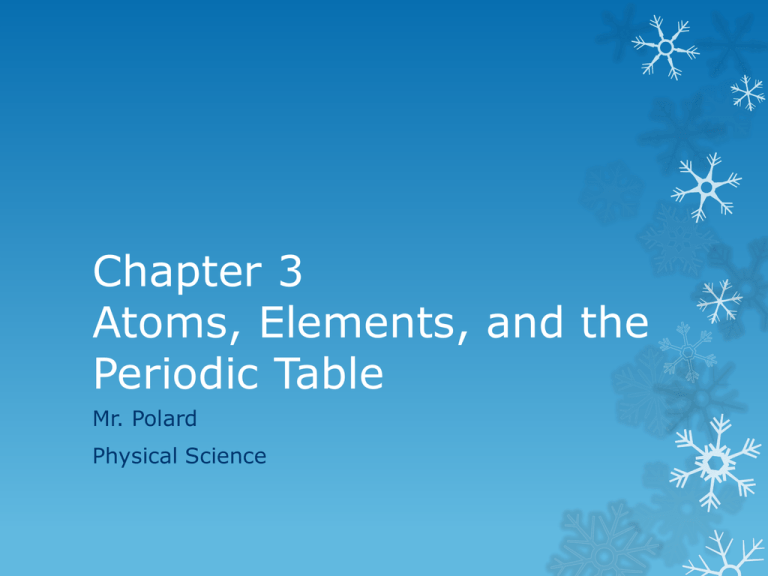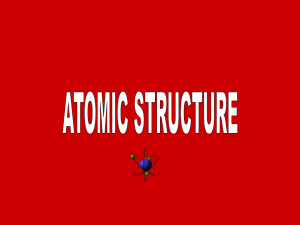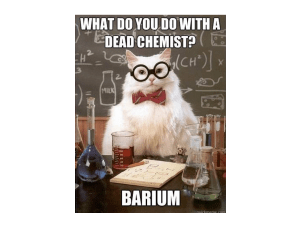Chapter 3 - Vocabulary and Notes
advertisement

Chapter 3 Atoms, Elements, and the Periodic Table Mr. Polard Physical Science Section 1 Structure of Matter Vocabulary – Section 1 Matter: Anything that takes up space and has mass (pg72) Atom: A very small particle that makes up most kinds of matter and consists of smaller parts called protons, neutrons, and electrons (pg73) Law of Conservation of Matter: States that matter is not created or destroyed but only changes forms (pg74) Electron: Invisible, negatively charged particle located in a cloudlike formation that surrounds the nucleus of an atom (pg76) Vocabulary – Section 1 Nucleus: Positively charged, central part of an atom (pg77) Proton: Positively charged particle located in the nucleus of an atom and that is counted to identify the atomic number (pg77) Neutron: An uncharged particle located in the nucleus of an atom (pg78) Notes – Section 1 A. Matter – anything that has mass and takes up space. 1. The atom – a small particle that makes up most types of matter. 2. Lavoisier introduced the law of conservation of matter – matter is neither created nor destroyed, but only changes form. 3. Before Lavoisier, people used to think matter could appear and disappear. 4. Dalton introduced an early atomic theory of matter. a. Atoms are too small to be seen by the human eye. b. Each type of matter is made of only one kind of atom. Notes – Section 1 5. Thomson discovered that atoms are made of even smaller subatomic particles. a. Electrons – tiny, negatively charged particles with mass b. Proposed that an atom was a ball of positive charge with electrons embedded in it. 6. Rutherford suggested a new model of the atom. a. Nucleus – the positively charged central part of the atom b. Protons – the positively charged particles in the nucleus. c. Electrons are scattered in the mostly empty space around the nucleus. Notes – Section 1 7. Chadwick introduced neutrons – particles that come from the nucleus and have no charge 8. Electron Cloud Model – Electrons are so small and fast that they move in a cloud. Section 2 The Simplest Matter Vocabulary – Section 2 Element: Natural or synthetic material that cannot be broken down into simpler materials by ordinary means; has unique properties and is generally classified as a metal, metalloid, or non metal (pg 80) Atomic Number: Number of protons in the nucleus of each atom of a given element; is the top number in the periodic table (pg 83) Isotope: Two or more atoms of the same element that have different numbers of neutrons in their nuclei (pg 83) Mass Number: Sum of the number of protons and neutrons in the nucleus of an atom (pg 83) Vocabulary – Section 2 Atomic Mass: Average mass of an atom of an element; its unit of measure is the atomic mass unit (u), which is 1/12 the mass of a carbon – 12 atom (pg 84) Metal: Element that is malleable, ductile, a good conductor of electricity, and generally has a shiny or metallic luster (pg 84) Nonmetal: Elements that are usually gases or brittle solids and poor conductors of electricity and heat; are the basis of the chemicals of life (pg 85) Metalloids: Elements that have characteristics of both metals and nonmetals and is a solid at room temperature (pg 85) Notes – Section 2 A. Elements – matter made up of only one kind of atom 1. There are 115 known elements. 2. 90 naturally occurring elements, plus synthetic elements – made by scientists B. Periodic Table – Chart that organizes and displays information about the elements 1. Atomic Number – the top number in the element’s periodic table block a. Tells the number of protons in the nucleus of each atom of that element b. The number of protons remains constant in every atom of an element 2. Isotopes – atoms of the same element that have different numbers of neutrons 3. Mass number – number of protons plus number of neutrons Notes – Section 2 4. Atomic Mass – the number found below the element symbol a. The weighted average mass of an atom of an element b. The unit used for atomic mass is the atomic mass unit, which is given the symbol u. C. Elements fall into three general groups characterized by similar properties 1. Metals – majority of elements a. Shiny luster b. Good conductors of heat and electricity c. Most are solids at room temperature d. Malleable or can be shaped e. Ductile, or can be drawn into wires without breaking Notes – Section 2 2. Nonmetals – round on the right side of the periodic table a. Dull in appearance b. Poor conductors of heat and electricity c. Many are gases at room temperature. d. Brittle, cannot change shape without breaking e. 97 percent of the human body is made up of nonmetals 3. Metalloids – found between metals and nonmetals on the periodic table a. Have characteristics of both metals and nonmetals b. Do not conduct heat and electricity as well as metals c. All are solids at room temperature. Section 3 Compounds and Mixtures Vocabulary – Section 3 Substances: Matter with a fixed composition whose identity can be changed by chemical processes but not by ordinary physical processes (pg 87) Compound: A substance produced when elements combine and whose properties are different from each of the elements in it (pg 87) Mixtures: A combination of compounds and elements that has not formed a new substance and whose proportions can be changed without changing the mixtures identity (pg 89) Notes – Section 3 A. Substance – Matter that has the same composition and properties throughout B. Compound – Substance whose smallest unit is made up of more than one element 1. Chemical Formula – tells which elements make up a compound as well as how many atoms of each element are present a. The subscript number tells how many atoms of the preceding element are in the compound. b. No subscript is used when only one atom of the element is present. 2. A given compound is always made of the same elements in the same proportion Notes – Section 3 C. Mixture – Two or more substances mixed together which don’t make a new substance 1. Unlike in compounds, the proportions of the substances in a mixture can be changed without changing the identity of the mixture. 2. Examples: air, blood 3. Can separate mixtures easily 4. Homogeneous mixtures – the same throughout 5. Heterogeneous mixtures – you can see the different parts









